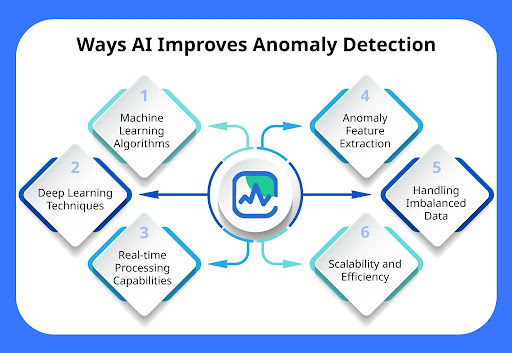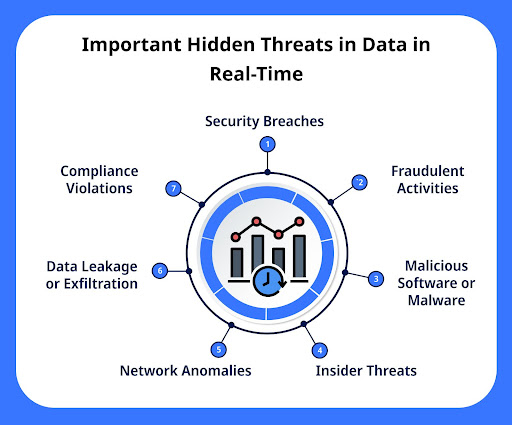Real-time anomalies and potential danger detection are crucial in today's data-driven environment. Traditional approaches frequently fail to accurately identify minute differences that can indicate a concealed threat.
Organizations and sectors that depend on quick action to counter possible threats are in danger because of this flaw in typical anomaly detection procedures.
The answer is AI in anomaly detection, a ground-breaking innovation that transforms how we identify covert threats in real-time data. This article will examine how AI changes anomaly detection procedures and improves our capacity to protect ourselves from new hazards.
How AI Enhances Anomaly Detection?
Anomaly detection has traditionally been carried out using conventional techniques. However, AI-powered technologies have raised the process's sophistication and accuracy. Here are some ways AI improves anomaly detection:

Machine Learning Algorithms: Anomaly detection systems are enabled by machine learning algorithms to learn patterns from data and make remarkably accurate distinctions between expected behavior and suspected anomalies. Through dynamic adaptation to changing threats and patterns, this skill improves detection abilities over time.
Deep Learning Techniques: A kind of machine learning called deep learning excels at finding subtle and complicated anomalies in massive datasets. Deep learning techniques, which use layers of neural networks, allow systems to recognize complex patterns that can evade conventional detection approaches, making them invaluable for finding covert threats.
Real-time Processing Capabilities: AI in Anomaly detection systems can process real-time data. As a result, anomalies can be quickly detected and flagged, enabling quick response and mitigation. Real-time processing is essential in contexts where even a small delay in anomaly detection could have serious repercussions.
Anomaly Feature Extraction: Anomaly feature extraction is the automatic extraction of pertinent features from data by AI using a sophisticated algorithm. As a result, complicated anomalies that could otherwise go undetected can be found. AI enables anomaly detection systems to precisely identify hidden risks by recognizing minor patterns.
Handling Imbalanced Data: By their very nature, anomalies are rare occurrences. AI models perform well in datasets with an uneven ratio of normal data to anomalies. AI ensures that the majority class does not obscure infrequent anomalies by employing strategies like oversampling, undersampling, or specialized algorithms.
Scalability and Efficiency: Systems for AI-driven anomaly detection are built to scale. They are suited for contexts with huge volumes of incoming information because they can process enormous amounts of data in real time. This scalability guarantees that anomalies are quickly detected, enabling quick response and mitigation.
Hidden Threats in Data in Real-Time
For the protection of crucial systems and sensitive data in the age of rapid data generation, it is crucial to detect and mitigate the hidden threats in data in real time. The following are some important threats that require prompt attention:

-
Security Breach
One of the most severe unrecognized hazards to real-time data is security breach. These breaches may happen when unauthorized individuals access sensitive data, such as customer information, intellectual property, or financial records.
A security breach may result in severe financial losses, harm to one's reputation, and legal repercussions. Unusual access patterns can be found using AI-powered anomaly detection, which also helps organizations become aware of potential security breaches before they become more serious.
-
Fraudulent Activities
Financial fraud is still a big, unrecognized concern, both online and offline. To carry out illegal actions, cybercriminals use a variety of strategies, such as identity theft, credit card fraud, and account takeovers.
AI anomaly detection makes it possible to monitor financial transactions, spot suspicious patterns, and detect possibly fraudulent activity as it happens. This proactive approach is crucial to minimize financial losses and safeguard clients.
-
Malicious Software or Malware
Malware, including viruses, ransomware, and spyware, constantly threatens people and businesses. Malicious software can infect computers, steal confidential data, stop business activities, or kidnap data.
Real-time network traffic and system behavior monitoring are strengths of AI-driven anomaly detection systems. They can quickly detect deviations that indicate malware, enabling enterprises to respond immediately to control and neutralize the danger.
-
Insider Threats
One of the trickiest and sneakiest types of hidden hazard is insider threats. These threats are hard to identify using conventional techniques because they come from people inside an organization with access to systems and insider information.
By continuously observing user actions and interactions with confidential information, AI-powered anomaly detection excels at recognizing insider threats. Real-time alarms can be sent when they detect anomalous patterns, such as unwanted access or data exfiltration.
With the help of this proactive approach, enterprises may act right away to protect vital assets and stop any data breaches.
-
Network Anomalies
Anomalies in an organization's network infrastructure are called "network anomalies" and can take many forms. These anomalies may indicate several dangers, including hardware malfunctions and cyberattacks.
AI anomaly detection systems are excellent at keeping track of network traffic and spotting changes from the norm. AI can quickly identify odd activity like distributed denial of service (DDoS) assaults, data exfiltration, or unwanted access attempts by analyzing massive amounts of network data in real time.
-
Data Leakage or Exfiltration
Unauthorized access to and the subsequent extraction of sensitive data from a company's network or systems constitute data leaking, also known as data exfiltration. This covert threat may manifest in several ways, including cyberattacks, insider threats, or unintentional disclosures.
With AI-powered anomaly detection, companies may quickly identify and stop efforts at data leakage by seeing strange data access patterns, unexpected data transfers, or unauthorized data extraction.
Real-time network anomaly detection is essential for preserving network security and ensuring company operations continue without interruption.
-
Compliance Violations
For many industries, complying with regulations is a non-negotiable obligation. Inadequate controls, careless behavior, or intentional intent can all lead to hidden hazards connected to compliance infractions.
Anomaly detection powered by AI can track user activity, access patterns, and data flows to spot behaviors that violate compliance rules. By doing this, it helps businesses comply with industry-specific rules and keep away from fines or reputational harm brought on by non-compliance.
Final Words
AI anomaly detection comes with difficulties. Data professionals must be cautious regarding overfitting, class imbalance, and model interpretability. Balancing precision and recall is vital to achieve the desired performance.
All in all, anomaly detection is the compass that leads data professionals across unfamiliar areas of data analysis. You can find insightful information, reduce risks, and promote innovation by improving your anomaly detection abilities. You can hire AI developers if you need professional guidance and support.


No comments yet